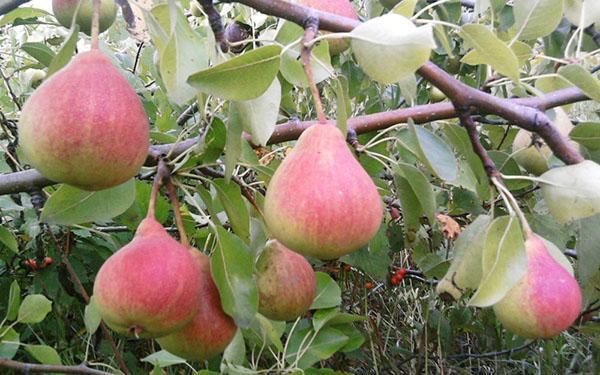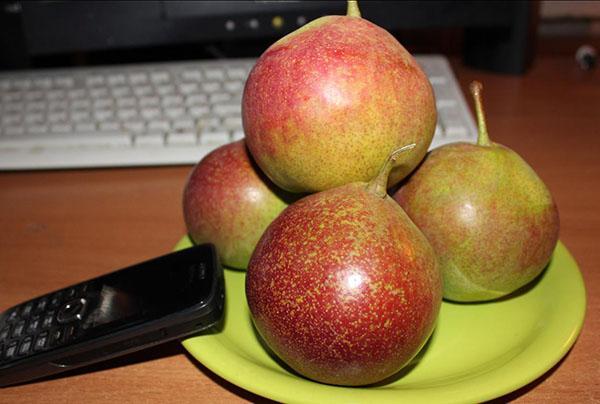Pleases with delicious fruits Marble pear
 Among the fruit trees, the Marble pear stands out favorably. Gardeners love her for her large sweet fruits and high yields. Even a novice summer resident can grow a healthy tree, subject to the rules of planting and care.
Among the fruit trees, the Marble pear stands out favorably. Gardeners love her for her large sweet fruits and high yields. Even a novice summer resident can grow a healthy tree, subject to the rules of planting and care.
Description of pear Marble

Planting in colder climates requires special care, as severe frosts can be detrimental to the marble pear. In this case, the seedlings should have a formed root system, and the planting site should be located in a sunny corner of the garden.
A characteristic feature of the tree is a straight trunk, up to 4 m high, vertically arranged branches and a pyramidal crown with elliptical foliage. Depending on the age of the culture, the bark can change color: red-brown in young shoots and greenish-gray in old ones. The flowering period begins in the second half of May.
The fruits ripen in late summer or early autumn and are distinguished by an unusual color: red vague spots on a yellow background resemble marble.
The yield of one tree per season is about 50 kg, and the weight of one fruit is on average 200 grams. The pulp is juicy and sweet. The characteristic of the Marble pear variety endows it with high commercial qualities and a long shelf life.
Landing technology
To grow a healthy and fruitful tree, you must carefully approach each stage and follow the recommendations of experienced gardeners.
Sapling selection

In order for the seedling to quickly take root and not get sick, it is worth purchasing it in specialized nurseries, taking into account a number of factors:
- The age of the planting material should not exceed 2 years.
- The bark should be free of roughness and defects.
- A two-year-old plant has 3-4 side branches.
- The root system is intact, about 30 cm long.
For additional protection of the root, it is better to give preference to a tree with an earthen ball.
Landing site
 For optimal development of the Marble pear, a well-lit area without a walking wind and with a high-quality drainage system (elevation). If possible, this should be the southern section of the garden, a few meters from the fence or wall. The culture loves loamy or loose soil with an admixture of peat, compost or humus.
For optimal development of the Marble pear, a well-lit area without a walking wind and with a high-quality drainage system (elevation). If possible, this should be the southern section of the garden, a few meters from the fence or wall. The culture loves loamy or loose soil with an admixture of peat, compost or humus.
If planted in a damp place or there is no good drainage, the tree will die.
Landing
Planting is carried out in late spring or early autumn. When planting several seedlings, it is necessary to place them no closer than 4 m from each other.
The work is performed in a specific sequence:
- A couple of weeks before planting, dig a hole 0.8 m deep and 0.6 m wide.
- Mix organic and mineral fertilizers with fertile soil, then fill half of the hole with it;
- Drive a peg 1.5 m high and 5 cm in diameter into the center of the pit as a support for the seedling;
- Carry out a visual inspection of the planting material for damage. Cut off the affected areas secateurs.
- Place the tree in the center of the recess, spread the roots and cover with soil so that the root collar is 5 cm above the ground.
- Tamp the soil and tie the seedling to the peg.
- Water at the rate of 20-30 liters under one root.
- Mulch the planting site with foliage, sawdust or straw.
The pollinators of the Marble pear are the varieties Orlovskaya Letnaya, Kafedralnaya, Severyanka or others that bloom in parallel with it. It is necessary that they are located in the area nearby.
Care rules
For healthy growth and abundant fruiting, high-quality and timely care is needed, which consists of seasonal pruning, watering, fertilization, treatment from insects and diseases.
Watering
 If the fruits begin to crumble, then the tree does not have enough moisture. To avoid this, it is necessary to monitor the condition of the soil under the pear, preventing it from drying out during the entire growing season.
If the fruits begin to crumble, then the tree does not have enough moisture. To avoid this, it is necessary to monitor the condition of the soil under the pear, preventing it from drying out during the entire growing season.
For proper watering, you should dig grooves around the trunk 10 cm deep, and pour water into them at the rate of 25 liters under one root, increasing the rate to 50 liters in dry times.
Top dressing
 The introduction of nitrogen-containing fertilizing is carried out with the beginning of flowering. For these purposes, 200 g of urea diluted in a bucket of water is suitable.
The introduction of nitrogen-containing fertilizing is carried out with the beginning of flowering. For these purposes, 200 g of urea diluted in a bucket of water is suitable.
At the end of fruiting, you need to dig up the ground around the tree and apply organic fertilizers: compost (5 kg), manure (2 kg) or bird droppings (1 kg).
Spraying with 1% urea solution has a beneficial effect on growth, which is carried out 1.5 weeks after the end of flowering, and then, after another 15 days.
It is possible to identify the lack of certain trace elements when examining the seedling. Lack of nitrogen affects the color of the foliage, and it acquires a pale green color. With a lack of calcium, the foliage becomes stained, and a deficiency of potassium will lead to a brown tint.
Pruning

High-quality planting and care with a marble pear cannot do without pruning. Before the start of the season, work is performed in early spring, and at the end - in the fall, before the onset of frost. The procedure is performed annually:
- For young seedlings under 2 years old, only dry or damaged branches should be cut.
- In the third year, only the trunk and 3 healthy branches should remain intact. Cut the rest by 70%.
- After a year, cut the main branch into 8 buds. Shorten the rest by 30% of the total length.
- In subsequent years, old, dry, diseased and frozen shoots should be pruned.
For work, it is necessary to use sharp tools: pruning shears, a saw or scissors, processing the cuts with garden pitch.
You can enjoy the juicy and tasty fruits of the marble pear from the sixth year of cultivation. Due to the properties of the variety, the fruit will retain its quality for a month after harvest.